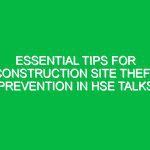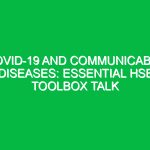Introduction
In today’s fast-paced work Environment, noise pollution poses a significant challenge to health, safety, and overall workplace productivity. Understanding Safety noise levels is crucial in the Health, Safety, and Environment (HSE) domain. Safety noise levels refer to the permissible exposure limits to noise in various occupational settings, ensuring that employees are protected from the detrimental Effects of excessive sound. This article will explore the essential aspects of Safety noise levels, their implications for Workplace Safety, and practical steps to mitigate noise-related Hazards.
Understanding Safety Noise Levels
Safety noise levels are measured in decibels (dB), a logarithmic unit that quantifies sound intensity. The higher the dB level, the louder the noise. For context, a whisper is about 30 dB, normal conversation hovers around 60 dB, and sounds above 85 dB can lead to hearing damage with prolonged exposure.
The Occupational Safety and Health Administration (OSHA) in the United States defines permissible noise exposure limits as follows:
- 90 dB for 8 hours: This is the maximum exposure limit for an 8-hour workday.
- 95 dB for 4 hours: After 8 hours at 90 dB, the limit drops to 95 dB for just 4 hours.
- 100 dB for 2 hours: At this level, maximum exposure time significantly decreases.
These limits are designed to protect workers from hearing loss and other health issues caused by prolonged exposure to high noise levels.
The Importance of Monitoring Safety Noise Levels
Noise-induced hearing loss is one of the most common occupational diseases, affecting millions of workers across various industries. In environments with high safety noise levels, employees may also experience increased stress, reduced concentration, and lower productivity. Monitoring safety noise levels is essential for several reasons:
- Health Protection: Regular monitoring helps identify hazardous noise levels, allowing for timely interventions.
- Regulatory Compliance: Adhering to osha and other regulatory Standards protects businesses from legal repercussions.
- Enhanced Productivity: Lower noise levels can lead to improved focus and efficiency among employees.
Identifying Noise Hazards in the Workplace
Various industries face unique noise challenges. For instance, construction sites, manufacturing plants, and airports are typically rife with high noise levels. Identifying noise hazards involves conducting noise assessments, which include:
- Noise Mapping: Creating visual representations of noise levels in different areas of the workplace.
- Sound Level Measurements: Using sound level meters to quantify decibel levels in various locations.
- Employee Surveys: Gathering feedback from workers about their noise exposure and its impacts.
A practical example can be found in a manufacturing facility where machinery operates at high decibel levels. If employees are consistently exposed to noise levels above 85 dB, the facility must implement noise Control Measures immediately.
Best Practices for Managing Safety Noise Levels
Implementing effective strategies to manage safety noise levels is vital for any organization. Here are some Best Practices:
1. Engineering Controls
Investing in engineering controls can significantly reduce noise exposure. Consider the following:
- Noise Barriers: Installing barriers or walls to block sound transmission.
- Sound Dampening Materials: Using acoustic panels or insulation to absorb sound.
- Equipment Modifications: Upgrading machinery to quieter models or retrofitting existing equipment with noise-reducing features.
2. Administrative Controls
Implementing administrative controls can also help manage noise exposure:
- Rotating Job Assignments: Limiting time spent in noisy areas by rotating employees.
- Scheduling Work Hours: Performing high-noise tasks during off-peak hours when fewer employees are present.
- Training and Awareness: Providing Training on the risks associated with noise exposure and how to protect oneself.
3. Personal Protective Equipment (PPE)
When engineering and administrative controls cannot adequately reduce noise levels, providing appropriate PPE is essential. Options include:
- Earplugs: Disposable or reusable earplugs can reduce noise levels significantly.
- Noise-Canceling Headphones: These can be particularly useful in environments where communication is not critical.
Case Study: A large manufacturing plant implemented a comprehensive noise management program that included engineering controls, administrative changes, and employee training. Within six months, reported noise-related health issues decreased by 40%, illustrating the effectiveness of a holistic approach.
Regulations and Standards Governing Safety Noise Levels
Compliance with Regulations is not merely a legal obligation; it is a moral responsibility. In the U.S., the OSHA standards for occupational noise exposure are stringent. The National Institute for Occupational Safety and Health (NIOSH) recommends an even lower exposure limit of 85 dB for an 8-hour workday.
In Europe, the European Union’s Directive 2003/10/EC sets forth requirements for noise exposure in the workplace. These regulations mandate that employers take action when noise levels exceed 80 dB and provide hearing protection when levels reach 85 dB.
Understanding these regulations is crucial for organizations to avoid penalties and ensure a safe working environment. Regular audits and compliance checks can help maintain adherence to these standards.
Implementing a Successful Noise Management Program
Creating an effective noise management program involves several key steps:
- Initial Assessment: Conduct a thorough assessment of current noise levels and identify potential hazards.
- Develop a Noise Control Plan: Outline specific strategies for reducing noise exposure based on assessment findings.
- Employee Training: Educate employees about noise hazards, protective measures, and the importance of compliance.
- Monitor and Review: Regularly monitor noise levels and review the effectiveness of implemented strategies, making adjustments as necessary.
A successful noise management program not only protects employees but also enhances overall workplace morale and productivity.
Conclusion
In conclusion, understanding and managing safety noise levels is a critical aspect of Workplace Health, safety, and environmental Sustainability. By actively monitoring noise levels, implementing effective controls, and adhering to regulations, organizations can protect their employees from the risks associated with excessive noise exposure.
The consequences of neglecting safety noise levels can be severe, affecting not only individual health but also overall productivity and organizational reputation. As we continue to navigate the complexities of modern work environments, prioritizing safety noise levels must remain at the forefront of Workplace Safety initiatives.
By taking proactive steps today, organizations can foster a safer, healthier, and more productive work environment for all.


